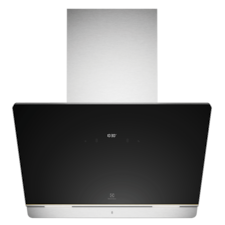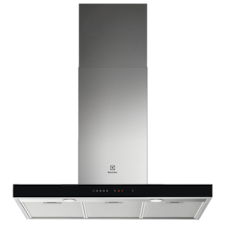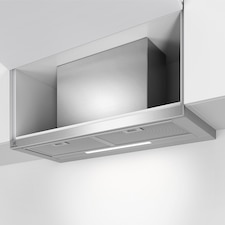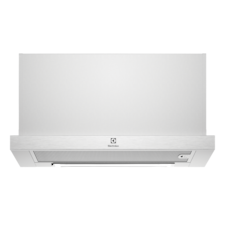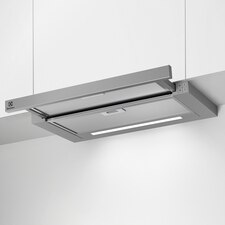A cooker hood is crucial for maintaining a clean, odor-free kitchen environment. It effectively removes cooking odors, smoke, grease, and fumes, protecting your health and preserving your kitchen cabinetry and surfaces.
Kitchen space & ventilation requirements
Proper measurement and ventilation planning are essential when choosing your cooker hood. Key factors to consider include:
- Kitchen measurement: Calculate kitchen volume (height x width x depth) and multiply by 10 to estimate the required extraction rate (m³/hr).
- Venting options: Ducted (extracts air externally) or recirculating (filters and recirculates air internally).
- Hood dimensions: Ideally, your cooker hood should match or slightly exceed the width of your stove.
- Cooking habits: High-heat cooking requires higher extraction power.
- Noise tolerance: Balance extraction power and noise levels.
- Installation constraints: Determine if your kitchen supports ducting.
Types of cooker hoods
1. Chimney hoods
Chimney hoods are wall-mounted, exposed units ideal for larger kitchens and households frequently engaged in cooking activities.
Ideal for: Large kitchens, frequent cooking, entertaining
Size: Typically 90cm
Features:
- Powerful extraction removes unwanted odours fast.
- Hob2Hood adjusts the hood power automatically.
- Control your hood settings with hand gestures.
- Glass touch control panel is easy to use and clean.
- BreezeRefresh automatically extracts air hourly
Buyer tip: Ensure you have enough wall and ceiling clearance for effective installation.
Recommended models:
- Powerful extraction removes unwanted odours fast.
- Control your hood settings with hand gestures.
- BreezeRefresh automatically extracts air hourly.
- Powerful extraction removes unwanted odours fast.
- Control your hood settings with hand gestures.
- Inverter motor is quiet, durable, and efficient.
- Hob2Hood® for absolute comfort
- Electronic touchscreen controls on the glass
- A high performance engine for fresh air
2. Telescopic range hoods
Telescopic hoods are retractable, compact units suitable for kitchens where space conservation is important.
Ideal for: Small to medium kitchens, apartments, integrated cabinetry
Size: 60-90cm
Features:
- Moderate extraction power suitable for regular cooking
- Retractable design for discreet appearance and easy usage
- Efficient lighting ensures clear visibility during cooking
- Multiple fan speeds tailored to various cooking needs
Buyer tip: Check cabinetry dimensions to ensure seamless integration and ease of use.
Recommended models:
- 3-speed fan to adjust to what you're cooking.
- Powerful extraction removes unwanted odours fast.
- LED lighting is bright and energy efficient.
- 2-speed fan to adjust to what you're cooking.
- Centrifugal motor is energy efficient.
- 5-layer filter efficiently removes grease.
- 3-speed fan to adjust to what you're cooking.
- Powerful extraction removes unwanted odours fast.
- LED lighting is bright and energy efficient.
Choosing the right range hoods size
|
Kitchen size |
Hood type recommendations |
Recommend width |
Optimal hood height above hob |
|---|---|---|---|
|
Small (<10 m²) |
Telescopic hood |
60cm |
Gas: 65-75cm; Electric: min. 50cm |
|
Medium (10-20 m²) |
Chimney or telescopic hood |
60-90cm |
Gas: 65-75cm; Electric: min. 50cm |
|
Large (>20 m²) |
Chimney hood |
90-120cm |
Gas: 65-75cm; Electric: min. 50cm |
- Ensure the cooker hood width matches or slightly exceeds your stove's width for effective extraction.
- Optimal hood height above hob ensures effective extraction and safe operation based on your type of stove.
Extraction & circulation methods
1. Ducted vs recirculating
- Ducted hoods: Vent cooking odors and smoke externally through ducts, providing more efficient and powerful extraction.
- Recirculating hoods: Filter the air internally through charcoal filters, suitable for kitchens without external ducting options. Easier installation but less powerful.
2. Extraction rate (m³/hr explained)
- The extraction rate indicates how much air the hood can remove per hour.
- Calculate your required extraction rate by multiplying your kitchen's volume (width x depth x height) by 10.
- High extraction rates (>700m³/hr) recommended for frequent or heavy cooking; lower rates are suitable for regular cooking.
Key features to consider
1. Noise level
- Measured in decibels (dB), quieter models operate around 40-60 dB.
- Electrolux's Breeze function provides quieter operation during low-intensity cooking.
2. Control methods
- IQ touch: Easy-to-use touch controls that offer intuitive adjustments.
- Hob2Hood technology: Automatically adjusts extraction power based on your hob's activity for convenience and efficiency.
- Gesture control: Allows hands-free adjustments, ideal during cooking when hands may be busy or dirty.
3. Lighting options
- LED lighting provides energy-efficient, clear illumination.
- Consider models with adjustable brightness or directional lighting for enhanced visibility during cooking.
4. Finish & design considerations
- Available finishes include white, natural, or dark stainless steel.
- Select finishes and designs that match your existing kitchen appliances and overall décor for aesthetic harmony.
- Integrated or built-in hoods offer a seamless look, while chimney or island hoods make stylish statements.
Filter maintenance & replacement
1. Types of filters
- Aluminum filters: Commonly used in ducted models; washable and reusable.
- Carbon filters: Used in recirculating models; require regular replacement (every 3-6 months).
2. Cleaning and replacement tips
- Regularly wash aluminum filters (monthly) to maintain extraction efficiency.
- Replace carbon filters regularly, according to usage guidelines, to ensure effective odor and smoke removal.
- Clean external hood surfaces frequently to prevent grease buildup and maintain appearance.
FAQs about Range hoods
-
1. How high should I install my cooker hood above the stove?
Install cooker hoods 65-75cm above gas hobs and at least 50cm above electric or induction hobs for optimal efficiency and safety.
-
2. What does extraction rate (m³/hr) mean and why is it important?
Extraction rate indicates the volume of air a cooker hood removes per hour. Higher extraction rates (700m³/hr or more) are ideal for frequent or heavy cooking, while lower rates suit regular, lighter cooking activities.
-
3. How frequently should cooker hood filters be cleaned or replaced?
Clean aluminum filters monthly to ensure efficient performance. Replace carbon filters every 3-6 months, depending on usage, to maintain effective odor and smoke removal.
-
4. Are cooker hoods noisy? How can I choose a quieter model?
Cooker hood noise is measured in decibels (dB). Quieter models typically operate between 40-60 dB. Electrolux models equipped with features like the Breeze function provide quiet operation, making them suitable for open-plan kitchens.

